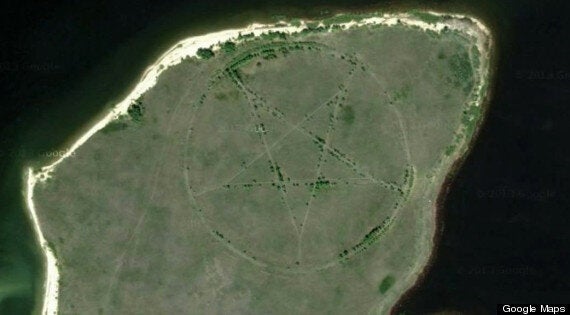A 1,200ft pentagram has been photographed etched into the ground in a remote corner of Kazakhstan.
The sign – which is often associated, thought not exclusively with black magic, devil worship and paganism – had baffled scientists.
It is situated on the southern shore of the Upper Tobol reservoir – more than 12 miles from the nearest city.

The 1,200ft pentagram is in a remote corner of Kazakhstan, 12 miles from the nearest city
Conspiracy theorists have been chomping at the bit, with Vigilant Citizen claiming significance in the fact the pentagram is shown to be inverted on Google Maps (which uses North-South orientation).
“In symbolism, an inverted figure always suggests a perverted power,” it says, citing 33rd Degree Freemason and expert in occult symbolism Manly P Hall.
Fuelling further rumours of the involvement of a satanic cult, the site adds: “A few days ago, when one would zoom into the pentagram with Google Maps, two strange locations would pop up, one named ‘Adam’ and another ‘Lucifier’ (a name often linked to the devil). However, since the story came out on the web, these locations disappeared and zooming into the pentagram is now disabled.”
Another theory, voiced by Kurt Yates, from Seattle, Washington, is that the symbol is an abandoned surface to air missile site.
SEE ALSO:
Writing on LiveScience, he explained: “I was a military pilot and these things are all over the place in areas that use(d) Russian (Soviet) air defence systems.
"The shape has something to do with how their tracking radars work." (For his pains, Josh Destardi replies: "Not a theorist, but an air missile site that just happens to be in the shape of a perfect pentagram? Don't buy it).
Though nothing has been officially confirmed, one woman believes she has solved the mystery.
“It is the outline of a park made in the form of a star,” archaeologist Emma Usmanova, who has spent years working in the area, tells LiveScience.
The five-pointed star (though not a pentagram) was a popular symbol during the Soviet era and were often used throughout the Soviet Union to decorate building facades, flags and monuments, NBC News points out.
There are more pictures of the now vastly overgrown patch of land from the ground over at EnglishRussia.com.
Google Earth periodically turns up some extraordinary sights from high above, just take a look at these: